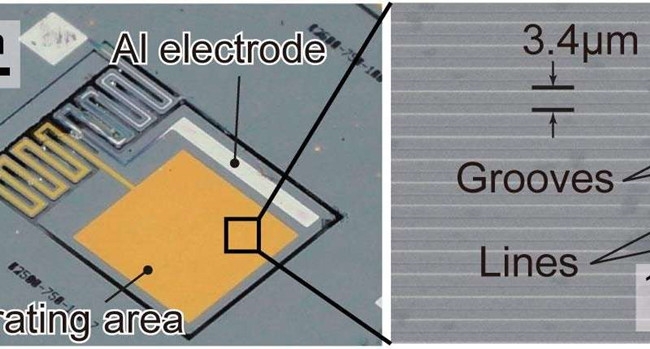[ Instrument Network Instrument R & D ] Near-infrared spectroscopy provides a material's unique absorption spectrum, so it can distinguish gas types. Therefore, there is a need for a miniaturized spectrometer to implement a compact gas sensor for monitoring air quality in a residential environment. However, conventional near-infrared spectrometers have gratings to disperse incident light into different wavelengths, so spectroscopy requires a longer optical path length, and it is difficult to miniaturize these devices.

Gold diffraction grating on a MEMS cantilever.
Now, Oshita Masaaki and Kan Tetsuo of the University of Electronic and Communication and their collaborators have developed gold diffraction grating-type plasmon photodetectors on MEMS (microelectromechanical systems) deformable cantilevers.
Currently, many researchers have studied many useful properties of plasma photodetectors, such as wavelength- or polarization-specific photodetectors. Although researchers have conducted in-depth research on the structure of reconfigurable plasmons, no reconstruction of the optical properties of plasmon photodetectors has been reported.
So here, researchers report a gold diffraction grating-type plasma photodetector that reconfigures its optical properties via a MEMS (microelectromechanical system) deformable cantilever. The researchers reconfigured the photodetector characteristics by using cantilever angular scanning in the range of -21 ° to 21 °, and found that the peak shift of the photocurrent signal waveform depends on the wavelength in the range of 1200-1500 nm, which is similar to SPR (surface (Plasma resonance technology) theory is consistent.
According to researchers, the device is manufactured using bulk micromachining technology using n-type silicon, and a gold diffraction grating is used for surface plasmon (SP) excitation purposes. When light is incident on the device, the mechanical vibration of the cantilever will dynamically change the incident angle of the light, thereby changing the plasmon (SP) coupling conditions. Coupled to SPR (Surface Plasmon Resonance Technology), light energy is converted into photocurrent on the device. The researchers used the cantilever angle change between -21 and 21 degrees to numerically retrieve the spectrum of near-infrared light by analyzing the photocurrent over time. As a result, researchers have finally implemented a miniaturized near-infrared spectrometer and are expected to produce new small IoT sensors.
Pet Chips Oil Grade,Pet Potato Chips Oil Grade,Bottle Grade Pet Chips,Pet Chips For Bottle Grade
Jiangyin jietong international trade company , https://www.jietongpetresin.com
![<?echo $_SERVER['SERVER_NAME'];?>](/template/twentyseventeen/skin/images/header.jpg)